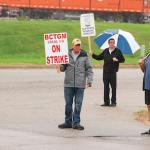Is This a Strike Wave?

Last week, in the space usually reserved for sage editorials, the New York Times published Tom Morello’s ode to the radical Industrial Workers of the World and to Joe Hill, that union’s martyred troubadour. The Wobblies, as they were called, were the advocates of a militant, all-inclusive unionism and their songs—like “Solidarity Forever” and “Bread and Roses”—inspired tens of thousands in the industrial war they waged against the ruling class of America’s first Gilded Age. A couple days earlier, Bret Stephens, the conservative Times columnist, warned Democrats not to link their fortunes too closely to a revival of the labor movement, something he seems to take for granted. In support he recalled the militant coal mine strikes that nearly wrecked the British economy in the 1970s. The “Winter of Discontent,” as it became known, divided the Labour Party and opened the door to Margaret Thatcher’s election in 1979.
Our thoughts have turned to Wobbly hell-raising and union militancy because of headlines like this one in the Washington Post: “Strikes are Sweeping the Labor Market as Workers Wield New Leverage.” There’s no doubt that many workers have quit rather than return to their old jobs in a world where the COVID-19 pandemic still lingers. Wages are going up amid this “labor shortage” and some unions have indeed chosen this moment to bargain for better contracts and hit the picket line should employers prove recalcitrant. Labor’s prospects are a lot different today than a decade ago, when a paltry government stimulus, mass unemployment, and a slow recovery made workers fear that any strike would just serve as an excuse for the employer to close the factory.
Are we witnessing a strike wave? The scale of the action is not, in fact, very large by historical standards. In 1979 there were 235 work stoppages involving more than 1,000 workers. So far this year there have been just twelve. But what may be even more significant is the cheerleading, the hope, and the expectation for a labor upsurge that has been manifest ever since scores of eager young journalists descended upon Bessemer, Alabama, last winter to cover the union effort there to organize an Amazon distribution center. American liberals know that something is missing from the body politic, and that something is a labor movement with sufficient strength to not only boost pay, but also wield the kind of political power that once pushed Midwestern Republicans to raise the minimum wage, vote for civil rights laws, and even increase social spending. If West Virginia had the union density today that it did at the start of Joe Manchin’s career, the mountain state would be solidly Democratic and its senior senator far more of an enthusiast for the social programs and tax-the-rich proposals he now scorns.
Both liberal pundits and union activists are therefore anxious to conjure up a strike wave out of the newfound militancy we’re seeing across the country. On the picket lines at John Deere, where 10,000 United Auto Workers members are on strike, and among the 60,000 film and television workers that might well reject the contract negotiated by their union leaders, some of that old Wobbly spirit has been unleashed. In California and Oregon, 24,000 employees of Kaiser Permanente—nurses, technicians, and other workers—voted to authorize a strike earlier this month. And from President Joe Biden on down, a lot of Democrats, finally, are saying they want labor to win.
The problem is that employers are not dumb. They have been raising wages to retain a workforce—you can get $19 an hour just by walking in the door at Amazon, and Dollar General is paying more than minimum wage. But they are strongly resisting the organization of their workers into a functional union—deploying all the economic power, legal talent, and law-breaking necessary to preserve managerial authoritarianism. In Buffalo this month, when workers at four Starbucks coffee shops made public their effort to win a National Labor Relations Board election, regional managers and “trainers,” all earning many times more than the embattled baristas, poured into the stores in an act of intimidation.
Non-union workers, no matter how aggrieved, do not go on strike. They can quit their job, even walk out together for a shift or two, but in the absence of some independent organization, almost always a trade union, their protest soon dissolves. Virtually every strike in today’s headlines, from that of the agricultural implement workers in Iowa, to the coal miners in Alabama, and the studio crews in Hollywood, are members of unions formed eighty years ago in the Great Depression. It does not matter if the union was once radical or conservative; organization is essential to any sustained and potent worker protest. And once the strike is over, that same organization does not fade away. It stays right there in management’s face, policing the contract, mobilizing the workers, lobbying politicians, and preparing for the next contract fight.
So, this isn’t a strike wave. We sorely need one, but that first requires the unionization of millions of new workers. Let’s therefore remember the words of Joe Hill just before he was executed by a firing squad in 1915: “Don’t mourn—Organize!”
